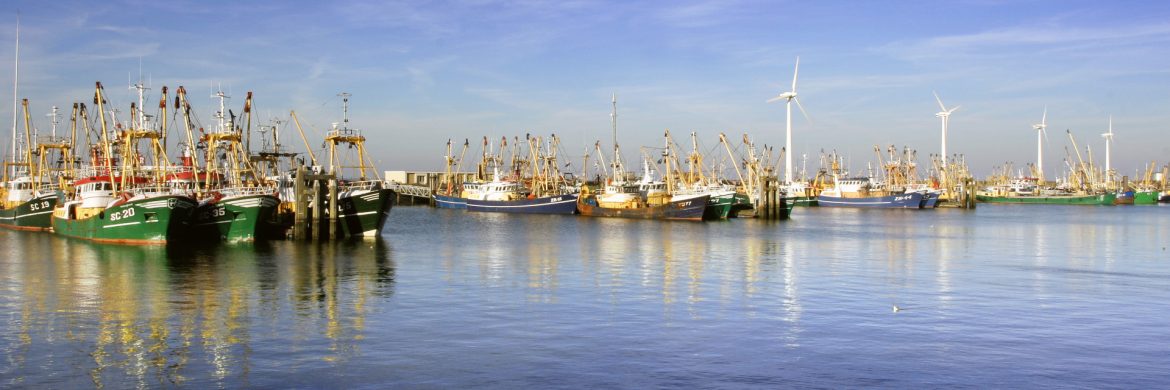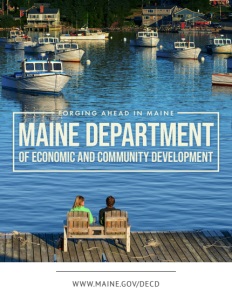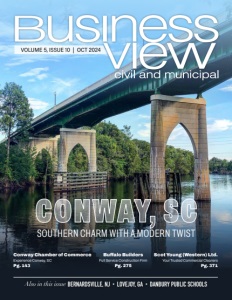Maine Department of Economic and Community Development
Forging Ahead In Maine
Spearheading economic growth with innovative strategies in workforce development, housing, and modernized incentives.
The Department of Economic and Community Development (DECD) in Maine is at the forefront of tackling economic challenges, with a particular focus on workforce development. As the state’s economic engine, DECD is responsible for creating a robust economic climate that supports business growth, job creation, and community prosperity. Under the guidance of Commissioner Heather Johnson, the department is navigating the complexities of the post-pandemic landscape with innovative strategies and initiatives.
Commissioner Johnson points out that Maine’s economic challenges mirror many other states, particularly workforce shortages. “Pre-pandemic, we were already projecting a workforce shortage,” she explains. This looming issue has driven state officials to act proactively. “The governor and our legislature have been partnering to invest in Maine’s workforce over the last five years,” she notes.
The approach is twofold: removing barriers for Maine residents to join the workforce and attracting talent from outside the state. Since 2022, these efforts have increased the workforce by approximately 20,000 people, significantly boosting the state’s economy. Workforce development in Maine is, however, not a one-size-fits-all solution. Commissioner Johnson describes a comprehensive strategy that includes a range of initiatives aimed at different population segments. For instance, Maine offers one of the nation’s most competitive student debt relief packages. “If you have student debt, regardless of your age, and you live and work full-time in Maine, there’s a tax credit available,” she says.
Leveraging Education for Growth
Education is another pillar of the DECD’s strategy. “The governor and the legislature have invested in making community college free for pandemic-impacted students,” Commissioner Johnson states. This initiative has led to a 12% increase in community college enrollment, indicating that removing financial barriers can directly impact workforce development. Furthermore, the department is promoting partnerships with the private sector through apprentice programs that represent a shared investment between the state and businesses to build a skilled workforce ready to meet Maine’s economy’s demands.
Commissioner Johnson also mentions an innovative program targeting high school juniors and seniors, offering them paid work experiences. “They have an opportunity to learn about careers and build professional networks in Maine’s economy,” she explains. Concomitantly, higher education institutions are also involved in this multifaceted approach. According to Commissioner Johnson, there’s a concerted effort to integrate internships and professional partnerships into the academic experience. “We want to make sure that the students are learning the skills that are competitive and needed,” she says, highlighting the need for Maine to ensure that its students are job-ready and aware of the diverse career paths available within the state.

Housing and Growth: Addressing Critical Needs
In recent years, Maine has experienced an influx of new residents, creating opportunities and challenges for the state’s economic development. This trend has intensified the need for a strategic approach to housing, an issue that Commissioner Johnson says has become a pivotal part of the state’s overall economic strategy.
“Affordable housing at all income strata in Maine is one of the things that we are focused on in partnership with communities and developers,” she explains. The demand for housing has surged, particularly between 2020 and 2022, when about 34,000 people relocated to Maine. Maine’s attractiveness partly drives this influx of people seeking a different quality of life. “People are interested in our climate work and some of the other visionary work that we’re doing here,” the commissioner notes, highlighting the appeal of Maine’s forward-thinking approach. While this interest is a positive sign, it has stressed the existing housing stock considerably.
Commissioner Johnson outlines a comprehensive study conducted across all counties to pinpoint housing shortages, identify cost bands where gaps exist, and understand how these limitations affect workforce availability. “We had a piece of legislation that went in around accessory dwelling units,” she says. Enabling property owners to build accessory dwelling units will create more housing opportunities while allowing residents to remain in their communities. This approach serves economic and social goals, supports Maine’s growing population, and maintains the character of its neighborhoods.
Unique Assets and Business Success Stories
Maine’s uniqueness includes its economic growth and development potential. Commissioner Johnson emphasizes that the state is rich in natural resources that are critical to solving global challenges, particularly in climate and technology. “These heritage industries create a solid base,” she says, referencing sectors like sustainable building materials and food production. Maine’s expertise in areas such as farming and fishing positions it well to meet the evolving demands of markets in the Northeast, especially in sustainable protein production.
This focus on sustainability is attracting young talent into Maine’s workforce. “We have a really bold climate strategy that is attracting young people into green tech jobs,” Commissioner Johnson explains, noting that there has been a significant increase in community college enrollment, with students pursuing careers in construction, green energy, and utility expansion. The state’s climate initiatives and emphasis on renewable energy work are driving growth in these sectors, offering a variety of opportunities for both new and existing residents.
Maine’s economic strategy also includes revitalizing former industrial sites and boosting rural communities. Commissioner Johnson shares the success story of TimberHP, a company that repurposed a dormant paper mill. “They are offering great job opportunities to people in a rural community,” she adds, a nod to the multifaceted benefits of this project. Re-employing former mill workers and contributing to Maine’s green initiatives makes TimberHP a prime example of how the state’s economic strategies are being implemented.
Other sectors in Maine are also experiencing growth, particularly those focused on sustainability. Commissioner Johnson notes that businesses are exploring new packaging solutions to replace single-use plastics, and the aquaculture industry is gaining momentum. “We’re seeing the development of oyster farming grow and bring in young, talented farmers,” she says, an outcome that meets the growing demand for sustainable protein while positioning Maine as a key player in the market. With the current situation where products like salmon are imported from abroad, Maine’s potential for local, sustainable growth continues to attract investment and innovation.

The Strategic Blueprint: Evolving Economic Goals
Maine’s economic development strategy, launched in January 2020, has been a cornerstone of the state’s growth efforts to address critical challenges. Crafted with input from over 1,300 Maine residents, including community leaders, business professionals, and academics, this plan sets out a vision for the state with a ten-year horizon.
Commissioner Johnson explains that this collaborative approach was essential in a state where collective action is highly valued. “The governor came into office and there was not an economic plan for the state,” she recalls. The need for a cohesive strategy was evident, prompting the creation of a plan that wasn’t just the governor’s vision but one representing the aspirations and input of the entire state.
“We set out to build this strategic plan for the state,” she says. This plan focused on three key goals, each designed with a long-term perspective. Alongside these goals, the plan outlined specific actions, creating a roadmap for implementation. Since its inception, the strategy has guided various project streams, offering a framework for action across sectors. “People could work together to actively engage,” she notes, indicating that the strategy provided a clear direction for public and private entities to align their efforts.
However, Maine’s economic development strategy is not static; it’s a living document that adapts to the changing economic landscape. Commissioner Johnson emphasizes that while the state measures its growth internally, it also benchmarks against other states to gauge competitiveness.
“We had a four-year period where our economy was growing 11th fastest,” she says proudly. Though Maine may not become the largest economy, this growth demonstrates the state’s ability to achieve significant GDP gains compared to other competitive states. “It’s good to see us able to be competitive at that level,” Commissioner Johnson adds, acknowledging that while there is still work to be done, the progress has been encouraging.
The commissioner also sees the state’s role as an enabler. “State government is an enabler, and its focus remains on supporting workforce skills, facilitating productivity, and collaboration among businesses,” she says. Moreover, she points out the unique advantage of being a smaller state: the ease of collaboration. “People will come to the table and want to work together in general,” she says. This willingness to engage and partner across sectors—academia, government, or private industry—creates fertile ground for initiatives that fuel growth.
Looking Ahead: Modernizing Economic Incentives and Holistic Development
As Maine progresses with its economic development strategy, the state will implement a modernized incentive package to stimulate growth while enabling collaboration between businesses and communities.
Commissioner Johnson outlines this new approach, which takes effect on January 1st, as a significant leap toward a more integrated economic framework. “We are excited to have a new, modernized economic incentive tool that really looks at capital investment and workforce skills as the two primary levers,” she says. This marks a departure from previous data-driven tools, emphasizing instead the importance of tangible investments and the cultivation of a skilled workforce.
The new incentive package is designed to create synergy between private sector growth and community development. Commissioner Johnson states that the goal is to facilitate mutual benefits for businesses and the communities in which they operate. “There’s an opportunity for both the community and the private sector to work together to see that kind of growth together,” she explains. The tool has garnered interest from developers eager to leverage it for projects that might have previously fallen outside traditional economic incentives.
“It also helps these medium-sized projects that often get left out of economic incentive tools,” the commissioner adds, pointing out that small and mid-sized businesses heavily drive Maine’s economy. For example, the recent development of 18 housing units near a new industrial site proved vital in securing the workforce needed for the investment. “That made all the difference,” she notes, illustrating how even smaller-scale projects can substantially impact local economic ecosystems.
This modernized approach to economic incentives is part of a broader strategy to create comprehensive support structures for economic growth. “All of the pieces have to fit together for success,” the commissioner says. In recent years, Maine has emphasized these “supportive elements” of economic development, recognizing their critical role in attracting and retaining investment. “They are key to the stickiness of that investment,” Commissioner Johnson adds, including factors like housing and childcare that contribute to a thriving business environment.
Maine’s approach to economic development continues to evolve, focusing on creating tools and strategies that are adaptable and responsive to the needs of businesses and communities. Implementing modernized incentive packages and considering the holistic needs of its workforce will enable Maine to create a robust economic environment that benefits all stakeholders. Commissioner Johnson and the broader leadership’s vision for the future is one where economic growth and community well-being go hand in hand, driven by collaboration and a shared vision for inclusive and sustainable progress.
AT A GLANCE
Maine Department of Economic and Community Development
What: State agency focused on fostering economic growth through workforce development, housing initiatives, and business incentives
Where: Maine, USA
Website: https://www.maine.gov/decd/


